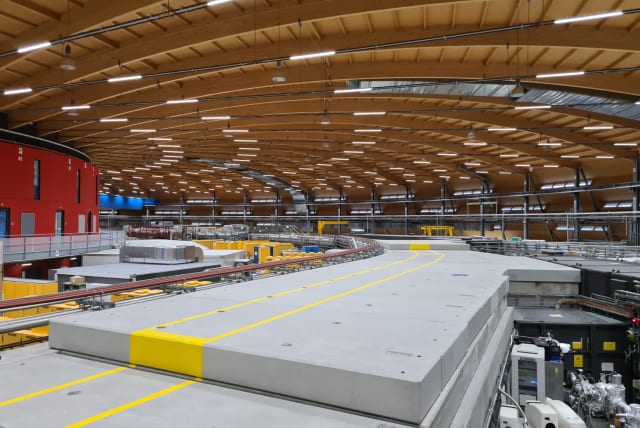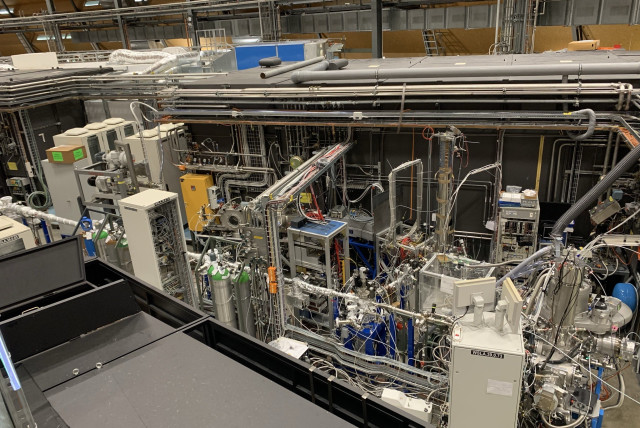More products to be produced with less material, pollution, fewer byproducts - BGU study

With these findings, those reactions could become more efficient – producing more products with less material, byproducts, pollution, and energy.
Surprisingly, one of the most important drivers of perhaps the largest industrial chemical reaction has never been observed in over a century of study. Reactions of three related molecules – ethane, ethyl, and ethylene – are the key factors in producing hundreds of millions of tons of plastic and other industrially important chemicals each year.
These chemical reactions are a key to both producing plastics and the combustion of natural gas, but researchers have been able only to theorize about how they work by analyzing final products because most experiments are unable to observe short-lived chemical intermediates, despite their importance in driving such reactions.
The last unobserved intermediate in the ethane pyrolysis reaction
Now, scientists at Ben-Gurion University of the Negev (BGU) in Beersheba have for the first time detected the last unobserved intermediate in the ethane pyrolysis reaction. With these findings, those reactions could become more efficient – producing more products with less material, byproducts, pollution, and energy.
Their findings, with their American and Swiss colleagues, have just been published in the prestigious journal Angewandte Chemie under the title “Direct Observation of the Ethyl Radical in the Pyrolysis of Ethane.”
“Observing this intermediate is the beginning of the path to making associated processes cleaner and more efficient, an important factor in industries such as plastics and natural gas,” said corresponding author Dr. Josh Baraban. His doctoral student Nadav Genossar-Dan led the theoretical and practical aspects of the experiment, which had originally been designed to target ethylidene – an elusive radical closely related to ethane and ethyl.
Ethane pyrolysis is a fundamental process in the global chemical industry and energy economy. More than 100 million tons of ethylene are produced annually by steam cracking of ethane at temperatures exceeding 1,000 K. As a major component of natural gas, ethane is also widely used for energy production, and the pyrolytic initiation of its combustion plays a central role here as well.
“The optimization of these processes through understanding the pyrolysis chemistry of ethane can reduce their economic, energetic, and environmental costs, but such advances are hindered by the elusive nature of the reactive intermediates that drive the associated reaction networks,” the tea, wrote.
“At first, I didn’t know what we had done,” admitted Genossar-Dan. “It was only when I was looking at the data we collected that I realized we had managed to observe this important chemical. Going back through the literature since the 1930s, I couldn't find a single researcher who had managed to observe it,” he added.
Genossar-Dan designed a flash pyrolysis experiment – heating the molecule until it cracks apart for very short times (a tenth of a millisecond). But he needed a synchrotron – an unusual tool based on an electron accelerator of which there are only a few dozen in the entire world – which can be used to produce vacuum ultraviolet light. He managed to book a one-week experiment in the Swiss Light Source synchrotron and then worked around the clock with three of his group members and the hosting scientist to run the experiments.
Since they are so rare, synchrotrons run nonstop, around the clock, and researchers must ask for permission to use them. Genossar-Dan's modeling explained the experiments and the findings completely. Now it is up to others to follow them. In the end, the demanding work, both designing and running the experiment, paid off as they made chemistry history.
Additional researchers included other PhD students from the group: Sharona Atlas (modeling), Dana Fux, Shani Har Lavan, Uri Zamir (participating in the experiment), Dr. Thanh Lam Nguyen of the University of Florida, and Dr. Patrick Hemberger (of the Swiss Light Source. The research was supported by the European Research Council under the European Union’s Horizon 2020 research and innovation program and by the Israel Science Foundation.
Jerusalem Post Store
`; document.getElementById("linkPremium").innerHTML = cont; var divWithLink = document.getElementById("premium-link"); if (divWithLink !== null && divWithLink !== 'undefined') { divWithLink.style.border = "solid 1px #cb0f3e"; divWithLink.style.textAlign = "center"; divWithLink.style.marginBottom = "15px"; divWithLink.style.marginTop = "15px"; divWithLink.style.width = "100%"; divWithLink.style.backgroundColor = "#122952"; divWithLink.style.color = "#ffffff"; divWithLink.style.lineHeight = "1.5"; } } (function (v, i) { });

